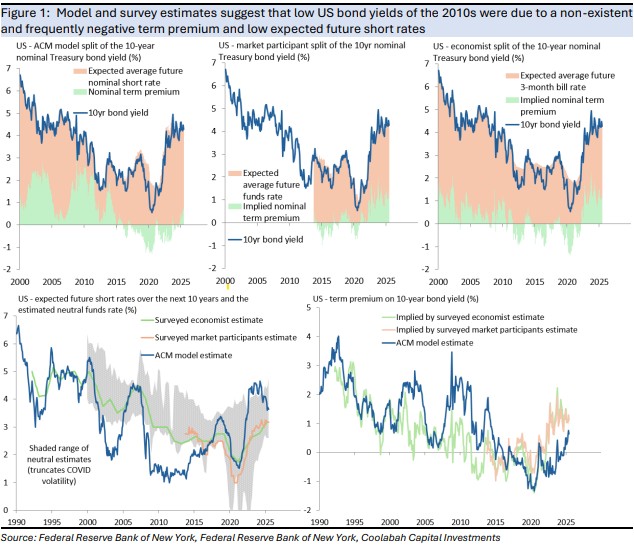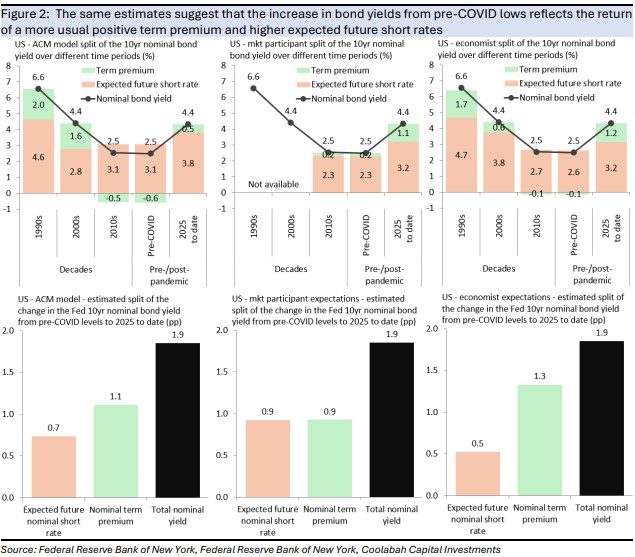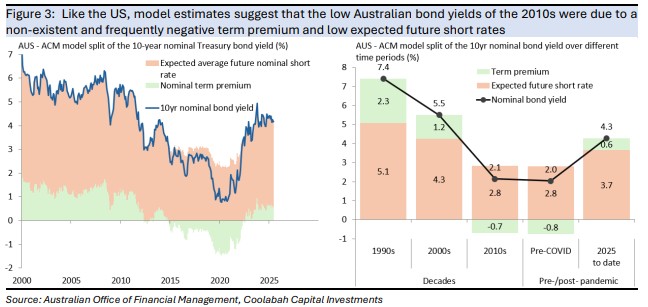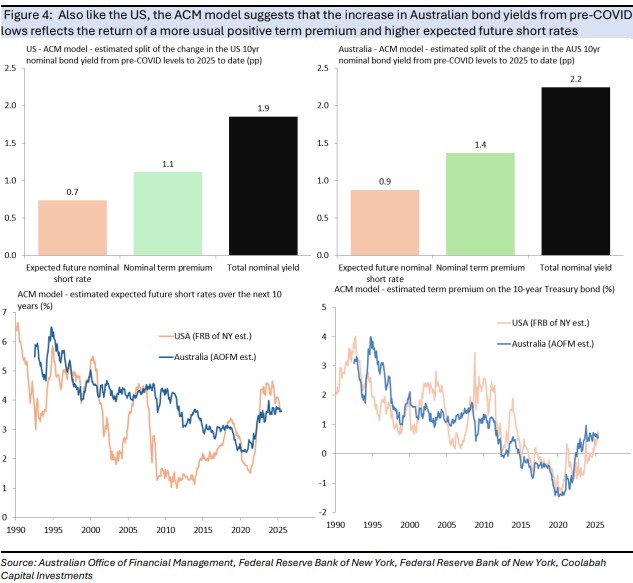The return of the term premium
The rise in bond yields from low pre-pandemic levels reflects the return of a more normal positive term premium - where investors need to be compensated for the risk taken in buying long-term bonds - and higher expected short-term interest rates.
Bond yields can be split into expected future short-term interest rates and a term premium using either a statistical model or relying on survey data.
- Nominal bond yield = expected future short-term interest rates + term premium.
The most common statistical approach relies on the ACM model that was developed by NY Fed economists, which is widely used by central banks and official issuers.
Survey data are patchy, but the term premium can also be estimated by subtracting surveyed expected future short rates from the bond yield.
In the US, the Federal Reserve Bank of New York polls market participants on the expected Federal funds rate over the next 10 years, but this series only has a short history. The Federal Reserve Bank of Philadelphia has a much longer history of economist expectations for the future 3-month Treasury bill rate over the next 10 years, but unfortunately these are annual data that require interpolation.
Another less common, but insightful approach uses the DKW model that was developed by Fed economists at the Board of Governors. This model provides a finer split of bond yields, comprising the expected real short rate, expected inflation, an inflation risk premium, and the real term premium.
Using the ACM and survey estimates to split the US 10-year bond yield into the expected future short rate and the term premium, the results broadly show that the very low bond yields of the 2010s were due to low expected future short rates and a practically non-existent term premium, which was frequently negative.
Low expected short rates were consistent with both low inflation and a low neutral policy rate at the time, where expected short rates are understandably correlated with estimates of the neutral rate (however, they are not identical as shown by NY Fed polling of market participants).
A non-existent and often negative term premium runs counter to the idea that investors should be compensated for the risk they take in buying long-term assets.
It likely reflected strong demand for bonds in the wake of the global financial crisis, where there was a global glut of savings and the Fed both bought bonds to stimulate the economy and signalled interest rates would stay low.
Low and relative stable inflation also reduced that small part of the premium related to inflation volatility according to the separate DKW model estimates.
In the wake of the pandemic, the Fed raised interest rates to contain inflation and 10-year bond yields increased from an average of 2½% prior to COVID to about 4½% in 2025 to date.
The ACM model and survey estimates suggest that about 1-1¼pp of this near-2pp increase reflects the return of a more usual positive term premium, with ¾-1pp due to a higher expected future short rate.
In the first half of this year, the expected future short rate has averaged about 3¼-3¾% on these two approaches, which is similar to the 3-4% range of the neutral policy rate based on Fed estimates and market pricing.
Over the same period, the term premium on these two approaches has averaged about ¾-1%, which is still below the experience of the 1990s and 2000s when the premium sometimes averaged as much as 2%.
In terms of the outlook, US 10-year bond yields could range between 4-5½% with a midpoint of 4¾% assuming the expected future short rate ranges between 3-4%, in line with the neutral rate, and if the term premium moves into a slightly higher range of 1-1½% given the worse outlook for the US budget.
Although poor demographics, including planned deportations, will weigh on expected future short rates, this influence is likely to be countered by fiscal stimulus and increased spending on AI and defence.
The term premium is harder to judge, but excess global savings and Fed buying of bonds is behind us, and US public debt is likely to reach a new record high as a share of GDP. The end of globalisation would also add a little to the term premium as it raises the risk that supply shocks lead to more volatile inflation than in the past.
The 4-5½% range with a midpoint of 4¾% is higher than estimates from the NY Fed’s survey of market participants, which suggests that the 10-year bond yield will fluctuate between about 4¼-4½% over the next couple of years, with a median estimate of about 4¼%.
The difference in calculations reflects market participants factoring in a smaller expected future short rate of between 3-3½% over the next ten years with a median of 3¼% and assuming that the term premium holds broadly steady at about 1%, not responding to a larger supply of bonds.
In Australia, the AOFM also uses the ACM model to provide a disaggregation of bond yields but unfortunately survey data on expected short-term interest rates – which can also be used to back out the term premium – are not as accessible.
The AOFM calculations tell a similar story to the US ACM model and survey splits of US bond yields, with the low Australian 10-year bond yield over the 2010s reflecting low expected future short rates and a non-existent and regularly negative term premium.
Like the US, low expected short rates in Australia post the global financial crisis were consistent with both low inflation and a low neutral policy rate.
Similarly, the non-existent and frequently negative term premium likely reflected strong demand for bonds in the years after the crisis, where there was a global glut of savings (the RBA also bought bonds, albeit on a smaller scale, to stimulate the economy and signalled interest rates would stay low).
Also like the US, the ACM model suggests that the increase in Australian bond yields from an average of about 2¾% prior to COVID to around 4¼% in 2025 to date reflects the return of a more usual positive term premium and
higher expected future short rates.
So far this year, the Australia term premium has rounded to about ¾% and could move into the ¾-1% range reflecting global trends and depending on the extent of the deterioration in the Commonwealth budget.
Using current economist estimates for the neutral policy rate as a proxy for the expected future short rate, they range between 2¼-4¼% with a median of 3½%. Adding an assumed term premium of ¾-1% would put the Australian 10-year bond yield at between 3-5½%, with a midpoint of about 4¼%, matching the average rate so far this year.
All this reinforces how interest rates are likely to stay high for some time and that the ultra-low rates of the pre-pandemic years are behind us.




5 topics

